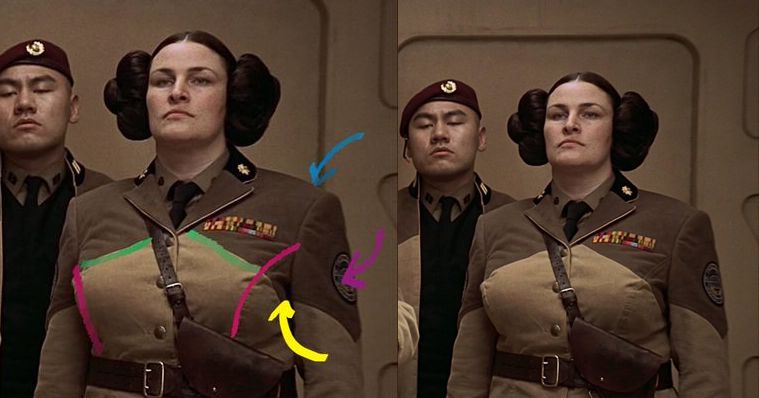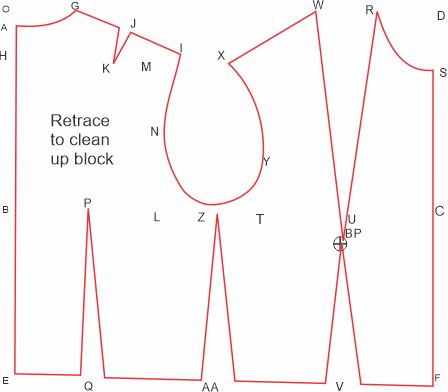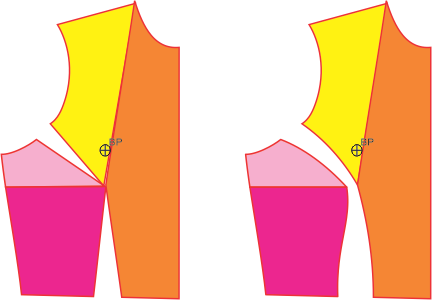This has always been one of the major reasons sewists turn to sewing if not the reason…period! The lure of fitting a pattern and therefore a garment to our bodies is always a plus. But there are a plethora of patterns as well as fitting challenges to each pattern, so how do we get that fit.
It’s not that it can’t be done, because we see it all the time in movies and on movie stars.

This is one of my all-time favorite photos of Octavia Spenser. On the right, we have her costume from the movie The Help where she portrayed a woman without much means and required to wear a uniform that came in prescribed sizes without any attention to fit or shape whatsoever. On the left, is the complete opposite – the same figure, shape and size only in a tailored jacket that fits beautifully. Let’s look carefully at this jacket because there’s a lot right that’s going on but it’s difficult to see because it is right. Yeah I know, sounds weird, but we seem to be able to see mistakes better than what’s right. First, the jacket closes without gapping or too much or too little fabric. Secondly, the jacket closes with the shoulders in the correct location. Check on the photo on the right to see how the ill-fitting garment closes – with the shoulder seam off way past the shoulder point, sloppy under the arm and closing poorly in front – either too small or in the case above, too much. The outfit on the right was to portray a part, mostly an ill-dressed character. Whereas the person on the right is someone accepting an award for her fine work and therefore looking as well-dressed and well-fitted as possible.

Here is another excellent example of a character in the movie, The Fifth Element, of a character portraying a well-trained, sharp military personnel. These costumes were designed by the Parisian couture designer, Jean-Paul Galtier who has extensive practice at fitting any and all shapes, and he shows us in spades that any shape, size, and style can be fitted.
So how do we get there? By drafting a pattern from scratch from your own measurements. When designer students go to designer school they learn how to draft patterns from scratch as well as how to drape. At school, they get lots of time to practice this and perfect their skill and craft which is something that those of us out of school don’t get. We have to contend with the daily chores, work and other necessities that must be done before we can get to sewing.
Except for right now, when we have gobs and gobs of time on our hands. So what better skill to learn than how to draft your own patterns. Let’s do something productive with all this time we have and from this, we can not only learn how to better fit ourselves but also make patterns that we can make clothes for.

Making a sloper means that you can build in a lot of the fit and shape that will work for your body. There will be some tweaking that you might need to do when you finish your sloper, but the majority of your sloper should fit. Now, the caveat here is that a sloper is a body double of your figure however it includes ease. This means that the whole sloper will fit closely to your body, but should contain ease.

This is NOT a garment and you shouldn’t try to make a garment out of this unless you want one of those Cheongsam dresses. This is a master from which you can design your own garments, but the amazing thing is that once you design your garment, you know it will fit cause your master fits. This means that from this pattern you can rotate darts, realign seams and fitting tools in the garment and…. well… design your own clothes from your sloper or block that you have drawn up.
Normally these slopers or blocks are filled with copious complicated explanations of how to do this. I used Metric Pattern Cutting for Women’s Wear, 5th Edition by Winifred Aldrich as a starting point and then instead of including extensive tables and computing equations in the steps, I broke those off into tables where the computations and math have mostly been done. This makes the process a lot easier and sort of channels the process into different skills so that you aren’t doing drafting then stopping to do the math, and then doing more drafting. For me, that’s like switching processes from one side of the brain to the other and that can lead to quick exasperation and wear down the gears in your brain’s transmission. It just makes the whole process harder.
It’s so much easier to do all the math for each step first and then you can go through and do the drafting after you’ve done the math. This is not like any other pattern alteration or pattern you’ve worked with before, so it can be a little scary and it is certainly treading into the unknown. But following each step, one by one, you can do this. The steps themselves aren’t hard, there are a lot of them which makes it look hard, but they are not hard.
I’ve come back to this recently after thinking this would be something really fabulously productive that is perfect for this time when we all have lots of time. Here’s the thing. It doesn’t take that long, but it does take some concentration and since we are all at home anyway – well, it seems like a perfect time to do this.
The Bodice Block/Sloper is located in the Resource Library, click here, and remember that till this COVID thing is over, everything in the Library is 20% off with the code COVIDGOAWAY. So not only do you have the time to do this, but everything is at a discount! There’s no excuse not to take this on.
To view the end result of my own sloper click here for a short video where I do some tweaking to my pattern and check it out.
As always, I really do want to hear your feedback, successes and any problem you might have with this. This sloper is such a fabulous tool, that to have one for yourself that works, is a truly empowering tool that you can use to make some wonderful, well-fitted garments for yourself.

Your explanation of Octavia’s uniform faults in fitting. However, I disagree that her jacket fits beautifully. It’s definitely better fitting than the uniform but, I think the circumference is too tight at the bust causing the fabric at the top closure to pull. The shoulder seam needs to be taken in and the underarm dropped to allow the the fabric at the armscye to hang smoothly.
The diagonal wrinkle at the bust indicates a need for a larger bust dart. Not a FBA.
I hope you’re not offended by my comments.
Thank you for all good info you provide and the friendly approach in the newsletter.
Heavens no – you disagree – that’s what makes the world go around! Mostly what was so refreshing about Octavia’s outfit was that her shoulder hit on her shoulders! What a concept. I know that sounds simple but most figures like hers that have a larger girth at the chest or bust, pattern makers seem to think that they must also have shoulders like the half back of some pro football team! As a result those shoulder like droops down half way across the bicep which is not the shoulder! And my big point is that when we sew, we too can make this alteration which isn’t all that hard to do, but our clothes today seem to say that it’s a requirement.
The outfit is too tight for me, but that’s all about the ill-fitting nature of clothes. We think that anything that has ease in it, is too baggy. It’s not, it has ease.
A simple look at Marlene Dietrich in pants and she has tons of easein them and were considered hugely fashionable and edgy at the time.
Or even today Amal Clooney in her pants, and these aren’t consider baggy at all.
Or even look at Chris Christie who has a large girth yet his pants aren’t considered baggy, they are considered well-tailored.
Clothes today have to be knit so that they stretch across the body for comfort, and then even those are normally way too tight. I much prefer a knit that drapes well, but that also has a flow to it, while the parts that are tight are flatteringly so. Tights are a perfect example of this – tight, yet they are not pants, so shouldn’t be worn as pants with tight tops on top.
In truth, I’m not interested in too much information about me or about anyone else. I really don’t want to reveal all the secrets of my body thankyouverymuch, and I’m really not interested
in all the secrets of even the most fittest of bodies.
Let’s leave a little to the imagination. It’s so much more fun!